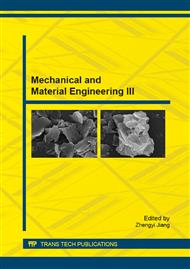p.148
p.152
p.159
p.164
p.168
p.174
p.179
p.183
p.187
Study on Dispersion of Carbon Nanotubes in Pb-Sn Electroplating Bath
Abstract:
In order to get homogeneously dispersed carbon nanotubes suspension for composite plating, carbon nanotubes were ball milled for different times and polycyclic acid (PA) was used as dispersant in this work. Sedimentation ratio was calculated by measuring the absorbance of suspensions and friction coefficient of the composite coatings was measured by friction tester. Dispersant content and ball milling time on the dispersive stability of suspension were studied. The dispersion mechanisms were discussed. The results showed that PA could effectively disperse carbon nanotubes in Pb-Sn electroplating solution. When the volume percent of PA was 0.3%, milling time was 6h and the milling speed was 300r/min, the sedimentation ratio was the smallest. The composite coatings had the smallest friction coefficient. Besides, the mechanism of PA effectively dispersing CNTs in Pb-Sn electro plating solution was electrostatics stabilization.
Info:
Periodical:
Pages:
168-173
Citation:
Online since:
July 2015
Authors:
Price:
Сopyright:
© 2015 Trans Tech Publications Ltd. All Rights Reserved
Share:
Citation:


